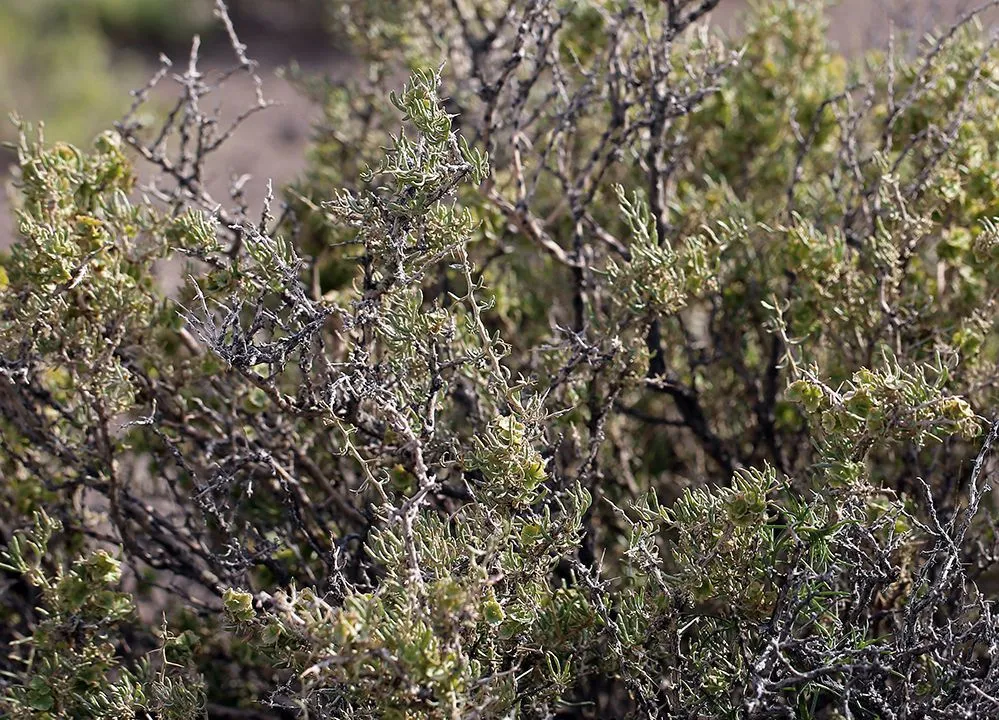
Author: (Hook.) Torr.
Bibliography: W.H.Emory, Not. Milit. Reconn. 2: 149 (1848)
Year: 1848
Status: accepted
Rank: species
Genus: Sarcobatus
Vegetable: False
Observations: WC. & C. Canada to Mexico (Sonora)
Greasewood, scientifically known as Sarcobatus vermiculatus, is a distinctive species of plant belonging to the Sarcobataceae family. Renowned for its tough and resilient nature, greasewood thrives across a remarkable range of geography, extending from western and central Canada down to Mexico, specifically the Sonora region.
Adapted to unforgiving environments, greasewood typically establishes itself in arid and semi-arid regions where few other plants can survive. Its ability to withstand harsh conditions, such as high salinity and minimal water availability, underscores its importance in these ecosystems. The plant is often found in alkaline flats and salt-desert shrub communities, thriving where other vegetation may struggle.
The physical appearance of greasewood is notable for its dense, thorny shrubs that can reach heights of up to 1.5 to 2.4 meters. The plant’s stems and branches are covered in small, fleshy, grey-green leaves that are highly adapted to conserve water. During certain seasons, the plant may exhibit tiny flowers which are not especially showy but are nonetheless crucial to its reproductive cycle.
In addition to its ecological adaptability, greasewood plays a significant role in soil stabilization and the reduction of erosion in desert environments. Its deep root system helps to anchor the soil, making it an integral component of the desert landscape.
Sarcobatus vermiculatus was first documented in scientific literature by W.H. Emory in 1848, a key moment that contributed to the broader understanding and study of the plant. The work of Emory, combined with the taxonomic classification detailed by Hook. and Torr., further solidifies the historical and botanical significance of greasewood.
Whether seen as a symbol of perseverance in nature or as an important ecological stabilizer, greasewood’s role in its native habitats is undeniably vital. It continues to be a subject of interest and study, particularly in understanding how plant life adapts to and thrives in some of the planet’s most challenging environments.
Eng: black greasewood, greasewood, saltbush, seepwood
Fra: sarcobate vermiculé
En: Greasewood, Saltbush, Seepwood, Black greasewood
Fr: Sarcobate vermiculé
Taken Jun 25, 2021 by Jordan M (cc-by-sa)
Taken Aug 24, 2020 by Fernández Javier (cc-by-sa)
Taken Aug 1, 2015 by EOL − Steve Matson (cc-by-nc)
Taken May 18, 2022 by Kelley Albrecht (cc-by-sa)
Taken May 18, 2022 by Kelley Albrecht (cc-by-sa)
Taken Aug 24, 2015 by EOL − Steve Matson (cc-by-nc)
Taken Aug 24, 2015 by EOL − Steve Matson (cc-by-nc)
Taken Feb 20, 2013 by EOL − Gerald and Buff Corsi (cc-by-nc-sa)
Taken Jun 24, 2014 by EOL − Mary Winter (public)
Taken Nov 23, 2009 by EOL − Gary A. Monroe (cc-by-nc)
Taken Jul 7, 2011 by EOL − Gravitywave (cc-by-nc-sa)
Taken Aug 24, 2008 by EOL − Steve Matson (cc-by-nc)
Taken Sep 16, 2009 by EOL − Barry Breckling (cc-by-nc-sa)
Taken Nov 23, 2009 by EOL − Gary A. Monroe (cc-by-nc)
Taken Aug 1, 2015 by EOL − Steve Matson (cc-by-nc)
Taken Aug 24, 2015 by EOL − Steve Matson (cc-by-nc)
Taken Feb 24, 1999 by EOL − Gerald and Buff Corsi (cc-by-nc-sa)
Growth form>: Multiple Stem
Growth habit>: Shrub
Growth rate>: Rapid
Ph maximum: 8.5
Ph minimum: 7.5
Family: Myrtaceae Author: (F.Muell.) K.D.Hill & L.A.S.Johnson Bibliography: Telopea 6: 402 (1995) Year: 1995 Status:…
Family: Rubiaceae Author: Pierre ex A.Froehner Bibliography: Notizbl. Bot. Gart. Berlin-Dahlem 1: 237 (1897) Year:…
Family: Sapindaceae Author: Koidz. Bibliography: J. Coll. Sci. Imp. Univ. Tokyo 32(1): 38 (1911) Year:…
Family: Asteraceae Author: A.Gray Bibliography: Pacif. Railr. Rep.: 107 (1857) Year: 1857 Status: accepted Rank:…
Family: Fabaceae Author: Medik. Bibliography: Vorles. Churpfälz. Phys.-Ökon. Ges. 2: 398 (1787) Year: 1787 Status:…
Family: Aspleniaceae Author: (Cav.) Alston Bibliography: Bull. Misc. Inform. Kew 1932: 309 (1932) Year: 1932…